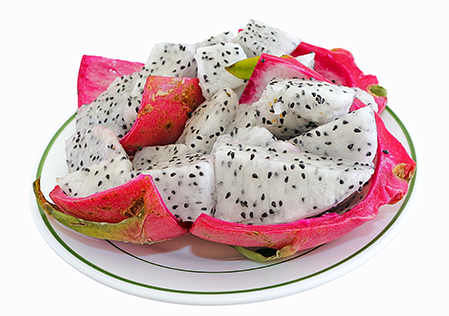Properties of the Pitaya (Dragon Fruit) and nutritional composition
 |
The
pitaya, pitahaya or also known as dragon fruit, is the name given to the fruit
of several species of cactus of the genera Hylocereus and Selenicereus, both of
the Cactaceae family.
Coming
from America, although its production has expanded to other regions of the
world, cultivating in countries such as China, Vietnam or Israel. At present,
it has also spread to southern Europe, on the Mediterranean coasts of Spain and
the Canary Islands.
The fruit
of the pitahaya has several types, but there are two kinds of edible varieties:
the "red pitahaya" and "yellow pitahaya", within each of
them can be classified by the color of the pulp.
Red skin
and red pulp called "Hylocereus costaricensis", yellow skin and white
pulp "Selenicereus megalanthus", red skin and red pulp
"Setenocereus thurberi" and the variety we show "Hylocereus
undatus", also known as white or round pitahaya, It has a red skin and its
white pulp with black seeds.

Hylocereus undatus (White Pitahaya)
The seeds
of the dragon fruit are rich in polyunsaturated fats (omega-3 and omega-6 fatty
acids) that reduce triglycerides and lower the risk of cardiovascular problems.
Its
composition is rich in water, antioxidants, vitamins, mucilages, phenols and
contains good amounts of minerals such as calcium, phosphorus, iron and
manganese.
Being a
fruit low in calories and sugars, it constitutes a healthy and balanced fruit
for diabetes.

Properties and benefits of Dragon Fruit
Oleic
acid: Is a monounsaturated fatty acid of the omega 9 series. According to the
American Heart Association, eating monounsaturated fats (such as oleic acid) in
moderation can help reduce bad cholesterol and therefore the risk of heart
disease and stroke.
Lycopene: Is a chemical that exists naturally in fruits
and vegetables, is a carotenoid (organic pigment) and an essential nutrient for
humans.


